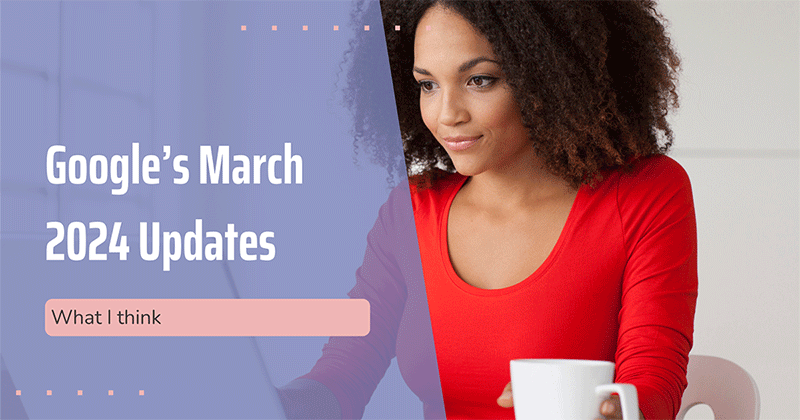Effective Action Based Copywriting
Seated at the Effective Action-Based Copywriting session with speakers Brain Clark (I will admit to being a huge Brian fangirl), Heather Lloyd-Martin and Jill Whalen. I’ll be sure to take extra careful notes today to prove to Jill that not all liveblogging is inaccurate. ;)
Heather says today is going to be a different format. It’s not going to be a lot of talking heads. This session is going to be very PowerPoint light. Most of the session will be Q&A and site reviews.
Heather is not only acting as moderator, she’s also our first speaker!
Content is not only important for search engine purposes, it’s also a must for users. The way you write your copy can make the difference between getting a so-so sale or having tremendous success.
Five Six Tips:
- Learning to love key phrases: Optimize for three related key phrase per page. Chances are you’re going to be focused on one key phrase per page with tertiary terms thrown in their, as well. That’s okay. It’s only natural for one term to be your money maker. How you focus your key phrases depends on the page type (Home, product, resource). As you get into the inner pages of your site, your key phrases will become more specific. Don’t fear key phrase overlap, it’s a good thing!
- Work with your word count: Words are wonderful because that’s what the search engines are indexing. It’s good to be able to provide information. Heather recommends using about 250 words per page. If it’s a product page, you can write less. If it’s an ecommerce site, you can write more. Heather doesn’t believe in key phrase density. As long as you can look at a page and see that it’s relevant for those phrases, you’re cool.
Power key phrase positions: Put keywords in the main body text copy, top to bottom, headlines and sub headlines, and in your hyperlinks.
- Pen tantalizing titles: The first opportunity for conversions is the on the SERP. When writing titles, think clickability, create unique titles for every page, include each page’s main key phrases, don’t necessarily target your company name (that’s something to test for clickthrough) and write each title to be between 50-75 characters. Heather says that key phrase rich content + Key phrase rich titles = search engine love.
- Mastering Google snippet trick: Place your benefit statements near your main key phrases. When Google takes your snippet for the SERP, the description will boost your benefits. It lets you control the description as much as you can. Google won’t always use the description that you wrote. This gives you another opportunity to make sure your benefits are front and center.
- Leverage lots of content opportunities: Content is not just your blog or product copy. It can be reviews. It’s anything you want to write about a product or service. Help people find you in a lot of different places. It helps to brand you as an expert.
- Remember what search engine optimization copywriting is and isn’t: Adding key phrases into content isn’t that big of a thing. Search engine optimization copywriting is the same as direct response copywriting. It makes arguments so convincing that customers can’t help but want to buy the product being advertised. It’s not the Easy Bake Oven approach where you throw in some key phrases and call it good. You write for you customers, not the search engines.
Jill Whalen is next.
Jill says this topic is near and dear to her heart. Back in 1994-6 people were talking about how to put the words on the page and trying to hide them. She used to see that all the time. She says she was the first person really talking about getting words on the page in a way that helps users.
What is Good Content?
It’s the regular pages on your site. It’s not mysterious. Every page should have content. It should speak to your target audience and describe what you do. It solves problems, answers questions and provides information. People are at your Web site because they’re looking for something, especially if they came from a search engine.
Content that is king is content that is written for your users, while keeping the search engines in mind. It’s all about balance, much like the see-saw image Jill’s is touting on her PowerPoint slide.
Good content starts with keyword research. You have to find the key words that people are using to try and find a site like yours. Base your copywriting around those words. Answer their search on your Web page.
Choose Keyword Phrases
For the home page, use the more general terms. The ones that describe your whole business in general. These are the more competitive phrases. As you get deeper into the site, use the more specific terms.
The engines have to be able to see your content. You don’t want to hide it. Avoid graphic headlines, all Flash or all graphic sites, and using technical programming that traps spiders. She uses the Web site for her son’s school as an example of how pretty, all graphical sites are nice, but Google can’t see them.
Search engine optimization writing tips:
- Be descriptive: Not "our product" or "our service". Use keyword phrases like "our Toronto event planning services".
- Edit your current text: Find generic words and replace them with descriptive ones.
- Don’t optimize for single words: Expand into phrases. "Marketing’ can become "Internet marketing strategy", "Marketing your business", "opt-in email marketing", etc.
- Fix your Site: You don’t need to add useless articles. Write clearly and descriptively to target your audience.
Content is indeed king. It brings highly targeted visitors that want exactly what your offer and converts them into customers.
Copyblogger’s Brian Clark is next.
Brian says he’s a lot like us. He builds Web sites. He’s not a professional copywriter.
How can you create a piece of content that attracts links and encourages conversions? No one is going to link to your sales page because a sales pitch has very little independent value.
Attention and Persuasion Checklist
- Independent Value: What can you offer customers to make yourself valuable? He mentions How To or tutorial content. This approach allows you to naturally create a story that leads to the action you want people to take.
- Headline and Hook: The headline is the title. The hook is the angle. It’s the beginning of what kind of story you’re going to tell. You have to create content that engages people, gets their attention and gets them to read. If you’re on the first page of Google, you’re competing with 9 people. There has to be more there than just repeating keywords.
- Scannable Content: People run their eyes right down a page. You need to chunk up your content in ways that allows you to communication your story even if people aren’t ready every word.
- What’s the Story: Ties everything together.
Example: You want to sell a product or something to that relates to people who want to sell ebooks. You find out your most relevant keywords are [create ebook] or [sell ebook]. He uses an article about ebooks that he wrote for Copyblogger as the example.
It’s hard to get people’s attention. He breaks down his content to show how it uses the Attention and Persuasion checklist he outlined above.
Selling Tips from Aristotle
- Opening: You’re trying to structure a story that has an opening statement. This is where your hook is.
- Empathy: You have to show people you understand their pain.
- Solution: The solution appears. You tell people what it takes to solve the problem.
- Action: You present your call to action.
It’s very hard to get people to link to something that’s selling something else. But it can be done. You just have to show that the value is there. It’s almost helpful to think of yourself as an affiliate marketer even if you’re selling your own stuff. It keeps your from touting your own horn. Look at is as a pre-sale.
Heather stresses the importance of the emotional component. You have to find people’s emotional button. Know what they like about working with you and what they don’t like about working with you.
Heather: When writing content, don’t be a bad date. If you’re always talking about yourself and telling people that you’re the best and the greatest, you’re going to push people away. Back it up with facts that show your expertise.

LEAVE A REPLY









